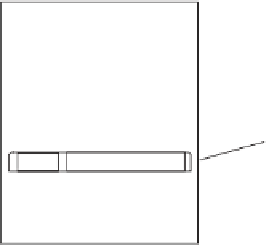Java Reference
In-Depth Information
Hashing is superefficient. It takes O(1) time to search, insert, and delete an element
using hashing.
Key
Point
The preceding chapter introduced binary search trees. An element can be found in
O
(log
n
)
time in a well-balanced search tree. Is there a more efficient way to search for an element in a
container? This chapter introduces a technique called
hashing
. You can use hashing to imple-
ment a map or a set to search, insert, and delete an element in
O
(1) time.
why hashing?
Hashing uses a hashing function to map a key to an index.
Key
Point
Before introducing hashing, let us review map, which is a data structure that is implemented
using hashing. Recall that a
map
(introduced in Section 21.5) is a container object that stores
entries. Each entry contains two parts: a
key
and a
value
. The key, also called a
search key
, is
used to search for the corresponding value. For example, a dictionary can be stored in a map,
in which the words are the keys and the definitions of the words are the values.
map
key
value
Note
A map is also called a
dictionary
, a
hash table
, or an
associative array
.
dictionary
hash table
associative array
The Java Collections Framework defines the
java.util.Map
interface for modeling maps.
Three concrete implementations are
java.util.HashMap
,
java.util.LinkedHashMap
,
and
java.util.TreeMap
.
java.util.HashMap
is implemented using hashing,
java.
util.LinkedHashMap
using
LinkedList
, and
java.util.TreeMap
using red-black
trees. (Bonus Chapter 41 introduces red-black trees.) You will learn the concept of hashing
and use it to implement a hash map in this chapter.
If you know the index of an element in the array, you can retrieve the element using the
index in
O
(1) time. So does that mean we can store the values in an array and use the key as
the index to find the value? The answer is yes—if you can map a key to an index. The array
that stores the values is called a
hash table
. The function that maps a key to an index in the
hash table is called a
hash function
. As shown in Figure 27.1, a hash function obtains an index
from a key and uses the index to retrieve the value for the key.
Hashing
is a technique that
retrieves the value using the index obtained from the key without performing a search.
hash table
hash function
hashing
0
1
2
.
.
i
= hash(key)
An entry
key
value
i
.
.
.
N
- 1
Hash function
F
IGURE
27.1
A hash function maps a key to an index in the hash table.
How do you design a hash function that produces an index from a key? Ideally, we would
like to design a function that maps each search key to a different index in the hash table. Such
a function is called a
perfect hash function
. However, it is difficult to find a perfect hash
perfect hash function




































Search WWH ::

Custom Search